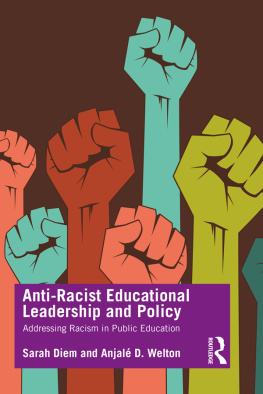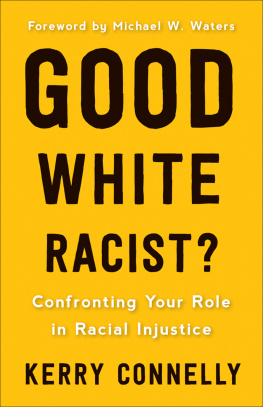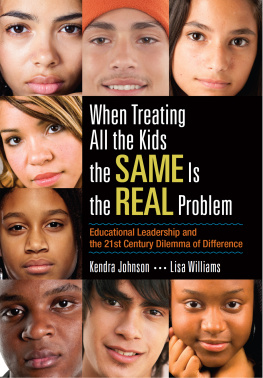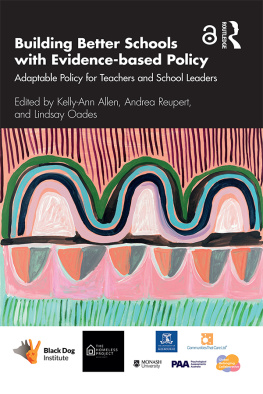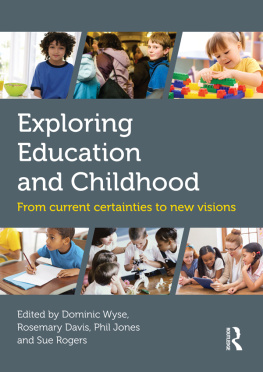Anti-Racist Educational Leadership and Policy
Addressing Racism in Public Education
Sarah Diem and Anjal D. Welton

First published 2021
by Routledge
52 Vanderbilt Avenue, New York, NY 10017
and by Routledge
2 Park Square, Milton Park, Abingdon, Oxon, OX14 4RN
Routledge is an imprint of the Taylor & Francis Group, an informa business
2020 Taylor & Francis
The right of Sarah Diem and Anjal D. Welton to be identified as authors of this work has been asserted by them in accordance with sections 77 and 78 of the Copyright, Designs and Patents Act 1988.
All rights reserved. No part of this book may be reprinted or reproduced or utilized in any form or by any electronic, mechanical, or other means, now known or hereafter invented, including photocopying and recording, or in any information storage or retrieval system, without permission in writing from the publishers.
Trademark notice: Product or corporate names may be trademarks or registered trademarks, and are used only for identification and explanation without intent to infringe.
Library of Congress Cataloging-in-Publication Data
A catalog record for this title has been requested
ISBN: 978-1-138-59697-9 (hbk)
ISBN: 978-1-138-59699-3 (pbk)
ISBN: 978-0-429-48722-4 (ebk)
Typeset in New Baskerville
by Newgen Publishing UK
To our familiesthank you for your love and unwavering support.
To the students, educators, administrators, families, organizers, and activists fighting for educational justice and racial equity every day across your school communitieswe thank you for your passion, humanity, and commitment to creating an education system all students deserve.
Contents
H. RICHARD MILNER IV
H. Richard Milner IV
Recently, I was conducting a professional development session with a group of educators (school counselors, teachers, leaders, social workers, and so forth), and I asked them if elementary school teachers should teach anti-racism. Interestingly, the overall response among the educators in the room was that they would address and respond to racism if they heard some racist comment from a student or if they saw a group of students being mean to another student based on race. As I probed, in general, what I heard from the educators was, I will address racism if I am forced to or in response to a particular situation. I was disappointed. What I tried to convey to the group of educators was that either they were working against racism, or they were working to maintain it.
Anti-Racist Educational Leadership and Policy: Addressing Racism in Public Education is an incredibly important book because it provides recommendations, tools, and insights about how school leaders and others build their anti-racist muscles in the fight for racial justice. By critiquing and calling out common sense policies and practices that have done more harm than good, Diem and Welton, drawing from empirical research, demonstrate what practitioners can do to transform their schools and build systems of racial equity.
There are no neutral spaces in the work of equity, racial justice, advocacy, and activism. Either we are working towards anti-racism or we are working against it. Either we are anti-xenophobia or we are maintaining xenophobia. Either we are anti-sexism or we are working to maintain sexism. But rather than focusing solely on what individual leaders and other educators can (and should) do to build their knowledge, understanding, insights, and expertise, this book is also about how to build policies that support institutional and structural spaces of equity and justice.
We are living in dangerously racist times. White supremacy, anti-Blackness, xenophobia, and hate are intensifying. Although such racism is not new, technological shifts and advancements provide us more opportunities to witness acts of discrimination in real time. Although some may believe issues of race are improving in the United States (U.S.), one could argue that we are regressing as a nation. Through technology, our ability to document and chronicle injustice provides opportunities for us to deepen what we know as well as engage in powerful dialogue about just how far we have (not) come in the U.S. in terms of race. White supremacist organizations are bolder, more vocal, and more overt in their racist attacks than they were years ago. The violent Unite the Right protests in Charlottesville, Virginia, and the subsequent killing of Heather Heyer provide a good example of white supremacy at work (https://time.com/after-charlottesville-ruddy-roye/). Moreover, racial divisiveness can be substantiated with the reactions to Colin Kaepernicks decision to exercise his right to kneel during the national anthem as a player in the national football league (Wagoner, 2016) to protest the police killing of unarmed Black people (https://theundefeated.com/features/colin-kaepernick-protests-anthem-over-treatment-of-minorities/). The Pittsburgh synagogue shooting where 11 were killed is another example (www.cnn.com/2018/10/28/us/pittsburgh-synagogue-shooting-victims/index.html). We also see an increase in media reports related to race as white people call law enforcement on Black people at appalling rates for seemingly mundane acts. Racism and xenophobia also manifest in immigrant children being confined to cages at the Mexican border, separated from their families for extended periods of time.
What roles should school leaders play in building school climates that address, disrupt, and build a proactive stance against the incidents described above? What is essential for educators to know, understand, and be able to do in order to cultivate curriculum practices in schools that center these societal injustices and incidents inside of school? Diem and Welton argue that schools must build systems through transformative ideologies to eradicate injustice. Moreover, these authors stress that the impact of equitable systems must move beyond the walls of the classroom and school. Anti-racism and advocacy, for educators and perhaps especially for school leaders, must be central to their stance in their work in schools, as Diem and Welton explain, in order to confront and eradicate racism in the world.

